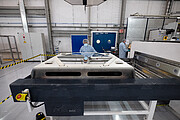Annuncio
First segments of world’s largest telescope mirror have a shiny new surface
14 Marzo 2024
The construction of ESO’s Extremely Large Telescope (ELT) in the Chilean Atacama Desert has reached a new milestone: a team at ESO’s Paranal Observatory have added a reflective, shiny layer, as well as special sensors, to the first segments of the telescope’s primary mirror. This “coating” means the segments are now essentially ready to start observing the skies, once installed at the heart of the world’s largest optical telescope later this decade.
The 39-metre primary mirror of ESO’s ELT, known as M1, will be by far the largest mirror ever made for a telescope. Too large to be made from a single piece of glass, it will consist of 798 glass-ceramic hexagonal segments, each about five centimetres thick and 1.5 metres across. The mirror segments are manufactured in Europe in a multi-step, multinational process. The first 18 made their way across the ocean to Paranal earlier this year, and coating is the next step on their journey — a milestone that three segments have now reached.
Coating an M1 mirror segment is a complex process that takes about two hours. In addition to a reflective layer, which uses 1.7 grams of silver, the coating includes additional layers of nickel chromium and silicon nitride to improve adhesion to the mirror blank and protect the silver from tarnishing. Overall, the coating is around 120 nanometres thick, or about one thousand times thinner than a human hair.
To make sure that all segments can work together as a single mirror, they are equipped with sensors to detect misalignments. Besides adding a coating to the first M1 segments, ESO engineers have also installed these so-called edge sensors, two per side of each segment, and integrated the electronics and mechanical supports needed for them to work. Finally, they have performed inspections and health checks to ensure that the segments are ready to be installed on ESO’s ELT. The entire process takes place inside a ‘clean room’ — where the number of particles in the air is carefully controlled to avoid contamination — in the ELT Technical Facility in Paranal.
The coating and integration procedures will be repeated for all other M1 segments. Meticulously testing and documenting the process for the first three segments was therefore key to ensure the operation can be ramped-up once new segments arrive at Paranal.
Once the telescope is operational, the coating process will be repeated on each segment every 18 months, to ensure the best reflectivity and sensitivity. In practice, this means that two segments will need to be recoated every day for the entire lifetime of the telescope. To facilitate this with minimal disruption to the scientific observations, an extra 133 segments are being manufactured, in addition to the 798 needed for the mirror. The world’s biggest eye on the sky is poised to tackle the most profound astronomical challenges of our time, promising groundbreaking discoveries once it sees first light later this decade.
Contatti
Bárbara Ferreira
ESO Media Manager
Garching bei München, Germany
Tel: +49 89 3200 6670
Email: press@eso.org
Riguardo all'annuncio
| Identificazione: | ann24005 |
Our use of Cookies
We use cookies that are essential for accessing our websites and using our services. We also use cookies to analyse, measure and improve our websites’ performance, to enable content sharing via social media and to display media content hosted on third-party platforms.
ESO Cookies Policy
The European Organisation for Astronomical Research in the Southern Hemisphere (ESO) is the pre-eminent intergovernmental science and technology organisation in astronomy. It carries out an ambitious programme focused on the design, construction and operation of powerful ground-based observing facilities for astronomy.
This Cookies Policy is intended to provide clarity by outlining the cookies used on the ESO public websites, their functions, the options you have for controlling them, and the ways you can contact us for additional details.
What are cookies?
Cookies are small pieces of data stored on your device by websites you visit. They serve various purposes, such as remembering login credentials and preferences and enhance your browsing experience.
Categories of cookies we use
Essential cookies (always active): These cookies are strictly necessary for the proper functioning of our website. Without these cookies, the website cannot operate correctly, and certain services, such as logging in or accessing secure areas, may not be available; because they are essential for the website’s operation, they cannot be disabled.
Functional Cookies: These cookies enhance your browsing experience by enabling additional features and personalization, such as remembering your preferences and settings. While not strictly necessary for the website to function, they improve usability and convenience; these cookies are only placed if you provide your consent.
Analytics cookies: These cookies collect information about how visitors interact with our website, such as which pages are visited most often and how users navigate the site. This data helps us improve website performance, optimize content, and enhance the user experience; these cookies are only placed if you provide your consent. We use the following analytics cookies.
Matomo Cookies:
This website uses Matomo (formerly Piwik), an open source software which enables the statistical analysis of website visits. Matomo uses cookies (text files) which are saved on your computer and which allow us to analyze how you use our website. The website user information generated by the cookies will only be saved on the servers of our IT Department. We use this information to analyze www.eso.org visits and to prepare reports on website activities. These data will not be disclosed to third parties.
On behalf of ESO, Matomo will use this information for the purpose of evaluating your use of the website, compiling reports on website activity and providing other services relating to website activity and internet usage.
Matomo cookies settings:
Additional Third-party cookies on ESO websites: some of our pages display content from external providers, e.g. YouTube.
Such third-party services are outside of ESO control and may, at any time, change their terms of service, use of cookies, etc.
YouTube: Some videos on the ESO website are embedded from ESO’s official YouTube channel. We have enabled YouTube’s privacy-enhanced mode, meaning that no cookies are set unless the user actively clicks on the video to play it. Additionally, in this mode, YouTube does not store any personally identifiable cookie data for embedded video playbacks. For more details, please refer to YouTube’s embedding videos information page.
Cookies can also be classified based on the following elements.
Regarding the domain, there are:
- First-party cookies, set by the website you are currently visiting. They are stored by the same domain that you are browsing and are used to enhance your experience on that site;
- Third-party cookies, set by a domain other than the one you are currently visiting.
As for their duration, cookies can be:
- Browser-session cookies, which are deleted when the user closes the browser;
- Stored cookies, which stay on the user's device for a predetermined period of time.
How to manage cookies
Cookie settings: You can modify your cookie choices for the ESO webpages at any time by clicking on the link Cookie settings at the bottom of any page.
In your browser: If you wish to delete cookies or instruct your browser to delete or block cookies by default, please visit the help pages of your browser:
Please be aware that if you delete or decline cookies, certain functionalities of our website may be not be available and your browsing experience may be affected.
You can set most browsers to prevent any cookies being placed on your device, but you may then have to manually adjust some preferences every time you visit a site/page. And some services and functionalities may not work properly at all (e.g. profile logging-in, shop check out).
Updates to the ESO Cookies Policy
The ESO Cookies Policy may be subject to future updates, which will be made available on this page.
Additional information
For any queries related to cookies, please contact: pdprATesoDOTorg.
As ESO public webpages are managed by our Department of Communication, your questions will be dealt with the support of the said Department.








